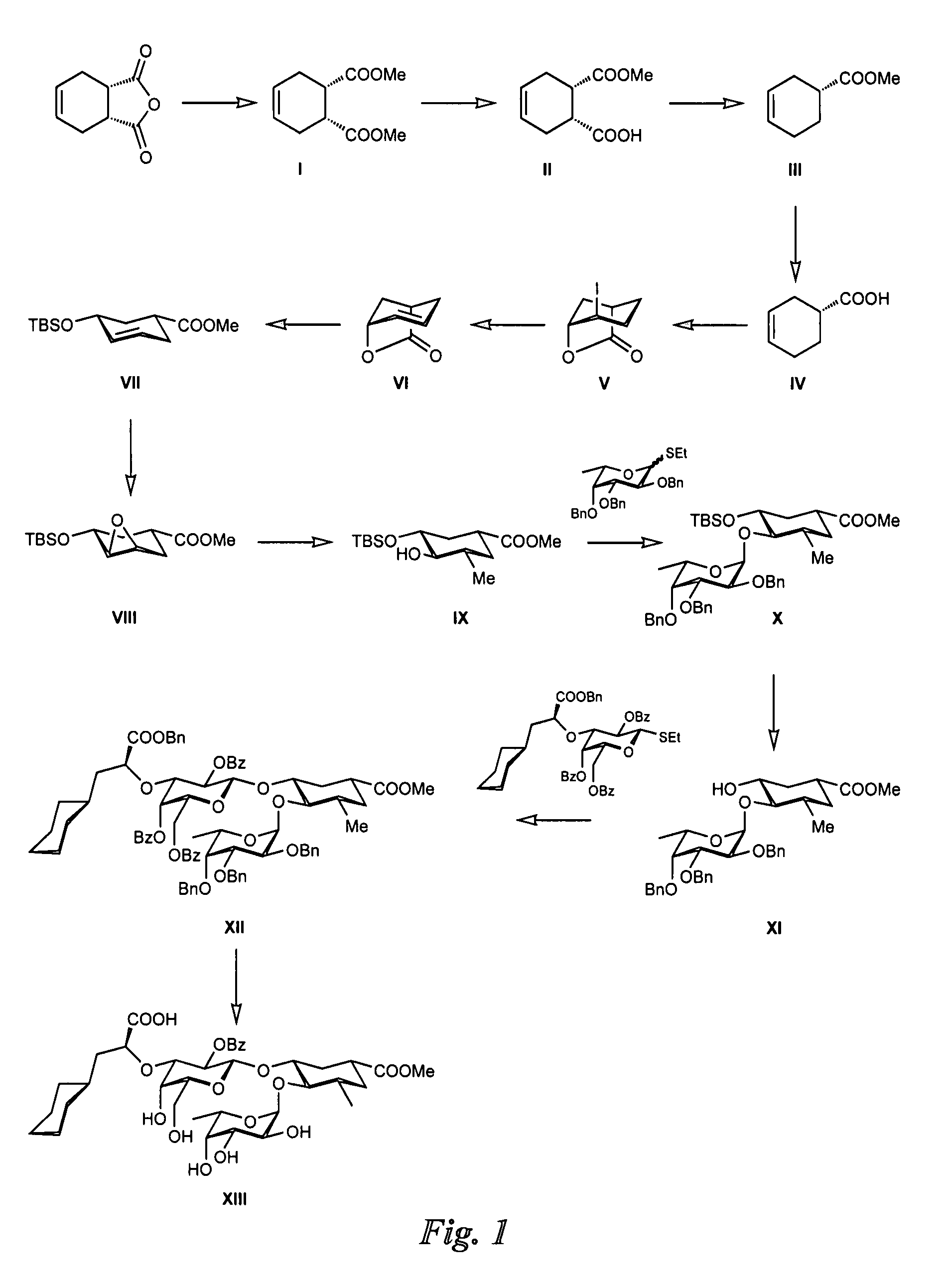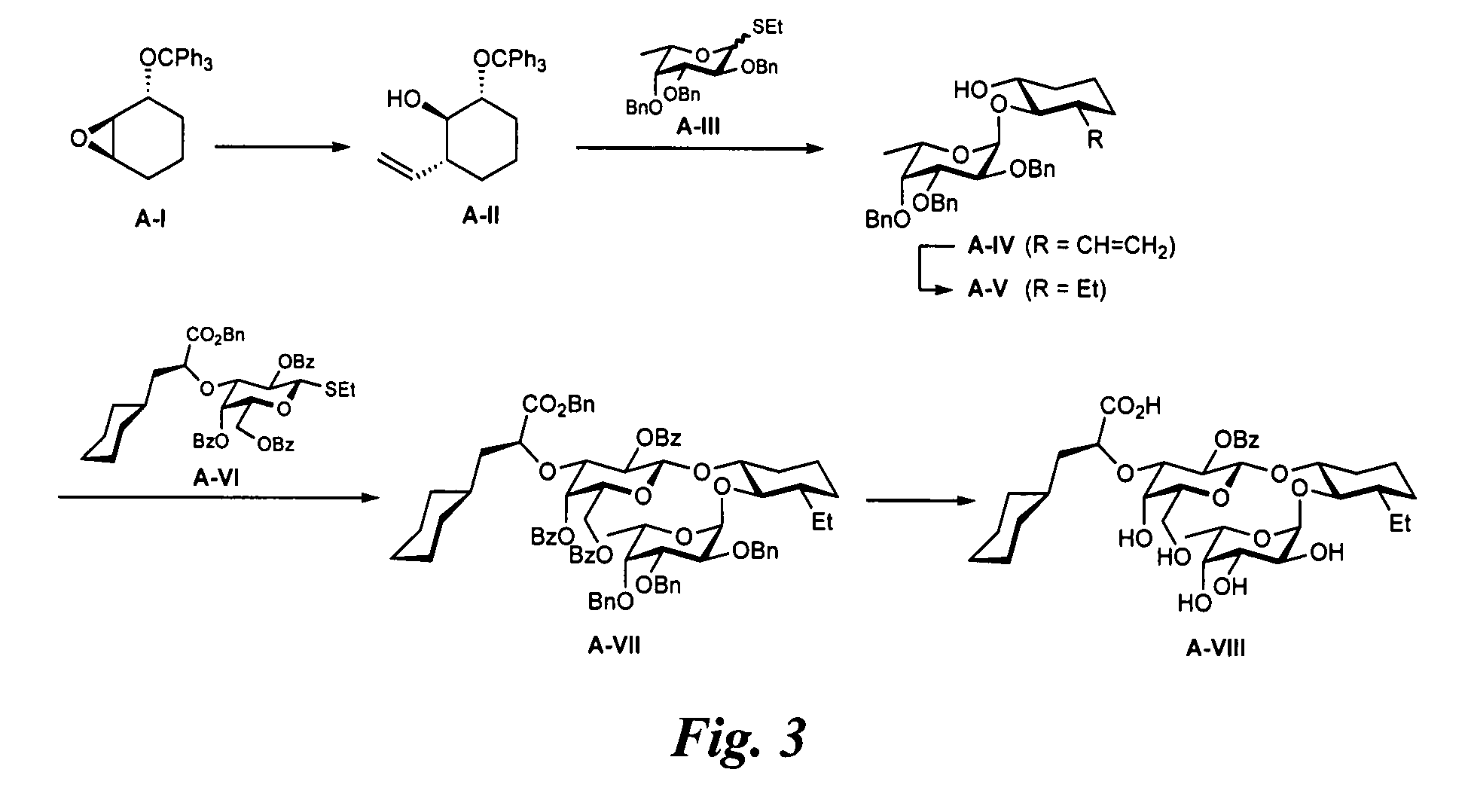Glycomimetic replacements for hexoses and N-acetyl hexosamines
a technology of n-acetyl hexosamine and glycomimetic replacement, which is applied in the field of obtaining oligosaccharide mimics, can solve the problems of increasing the number of problems, increasing the difficulty of producing monosaccharides and particularly oligosaccharides, and increasing the cost of production
- Summary
- Abstract
- Description
- Claims
- Application Information
AI Technical Summary
Benefits of technology
Problems solved by technology
Method used
Image
Examples
example 1
Synthesis of GlcNAc Mimic from Tetrahydrophthalic Anhydride (FIG. 1)
Synthesis of Intermediate I:
Amberlyste 15 (50.0 g) was placed in a flask and dried in high vacuo for 1 h. Methanol (1 l) was added, followed by cis-1,2,3,6-tetrahydrophthalic anhydride (50.0 g, 328 mmol) and trimethylorthoformate (100 ml, 914 mmol). The reaction mixture was then vigorously stirred. After 5 days, additional trimethylorthoformate (50 ml, 457 mmol) was added. The reaction was stopped after 9 days (TLC-control: petroleum ether / Et2, 1:2), filtered over celite and washed with methanol. The solvent was removed in vacuo (20 mbar). The brown residue was transferred with CH2Cl2 (150 ml) into a separation funnel and washed with satd. NaHCO3 solution and brine (each 150 ml). The aqueous layers were extracted 3 times with CH2Cl2 (3×150 ml). The combined organic layers were dried over Na2SO4, filtered and concentrated in vacuo (20 mbar) to afford diester I as a brownish oil (57.5 g, 88%).
Synthesis of Intermediate...
example 2
Synthesis of GlcNAc Mimics from Cyclohexenon (FIG. 2)
Synthesis of Intermediate XIV:
2-Cyclohexenone (9.8 ml, 101 mmol) was dissolved in CH2Cl2 (250 ml) in a light protected flask, then the solution was cooled to 0° C. Bromine (5.4 ml, 105 mmol) in CH2Cl2 (100 ml) was added via dropping funnel over 35 min. The clear yellow solution was stirred at 0° C. for 2.5 h, then Et3N (23.1 ml, 166 mmol) in CH2Cl2 (20 ml) was added portion-wise via dropping funnel, causing a color change from clear yellow to brown with precipitate. The mixture was stirred at room temperature for 2 h, then stopped. The reaction mixture was diluted with CH2Cl2 (50 ml) and washed twice with HCl 3% (2×50 ml). The aqueous layers were extracted with CH2Cl2 (2×25 ml) and the combined organic layers were washed with a mixture of brine (80 ml) and water (100 ml). The layers were separated and the aqueous layer was extracted with CH2Cl2 (2×50 ml). The combined organic layers were concentrated in vacuo to afford a brown res...
example 3
{(1R,2R,3S)-2-[(6-Deoxy-α-L-Galactopyranosyl)Oxy]-3-Ethyl-Cyclohex-1-yl}2-O-Benzoyl-3-O-[(1S)-1-Carboxy-2-Cyclohexyl-Ethyl]-β-D-Galactopyranoside (A-VIII; FIG. 3)
General Procedure a for Nucleophilic Opening of Epoxide A-I with Cuprate Reagents.
CuCN (3.81 mmol) was dried in vacuo at 150° C. for 30 min, suspended in dry THF (10 mL) and cooled to −78° C. A solution of the appropriate organo lithium compound (7.63 mmol) was slowly added via syringe and the temperature was raised over a period of 30 min to −20° C. and the mixture stirred at this temperature for 10 min. The mixture was cooled to −78° C. followed by the addition of freshly distilled BF3 etherate (1.53 mmol) in THF (2 mL). After stirring for 20 min, epoxide A-I (0.761 mmol) dissolved in THF (8 mL) was added. The reaction was slowly warmed to−50° C. over 5 h and then stirred at this temperature for 24 h. After slowly warming the reaction to −30° C. over another 21 h the reaction was quenched with a 25% aq. NH3 / satd. NH4Cl (1...
PUM
| Property | Measurement | Unit |
|---|---|---|
| mass | aaaaa | aaaaa |
Abstract
Description
Claims
Application Information
 Login to View More
Login to View More - R&D
- Intellectual Property
- Life Sciences
- Materials
- Tech Scout
- Unparalleled Data Quality
- Higher Quality Content
- 60% Fewer Hallucinations
Browse by: Latest US Patents, China's latest patents, Technical Efficacy Thesaurus, Application Domain, Technology Topic, Popular Technical Reports.
© 2025 PatSnap. All rights reserved.Legal|Privacy policy|Modern Slavery Act Transparency Statement|Sitemap|About US| Contact US: help@patsnap.com



